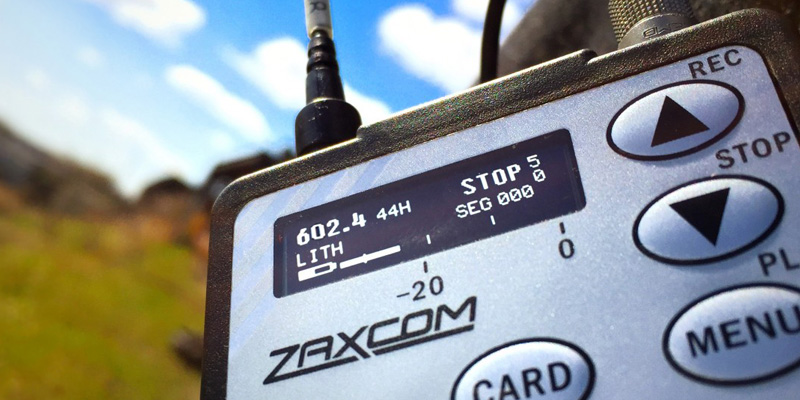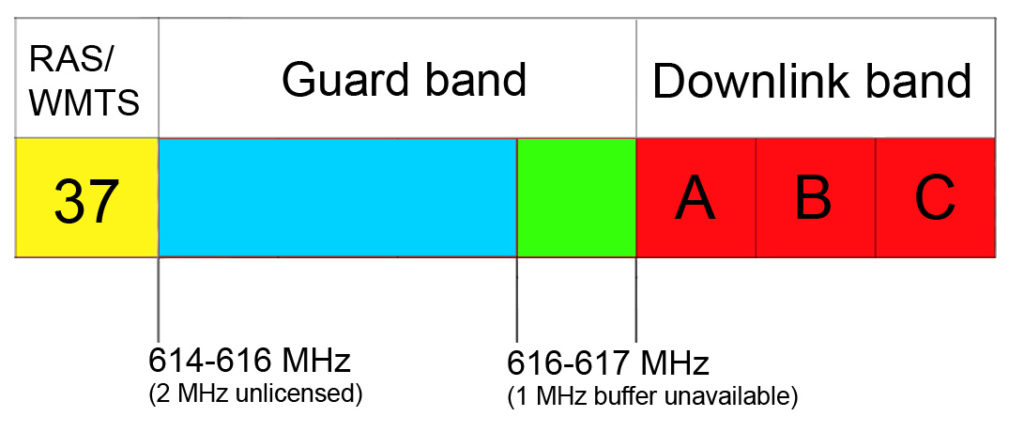The UHF TV band is shrinking. Here’s what you need to know and how it impacts Zaxcom devices.
Updated September 26, 2017

In the coming months, many sound recordists, stadiums, venues, theaters, churches and others will be affected by the Broadcast Incentive Auction which shifted airwaves from TV broadcasters to the cellular and cable companies.
Going forward, wireless microphones, in-ear monitors, IFB systems and intercom systems will be forced to adapt to new requirements set by federal regulations.
What is the incentive auction
The Federal Communications Commission (FCC) held an incentive auction, the Broadcast Incentive Auction, to repurpose a chunk of the UHF TV band to potential bidders which closed March 2017. The auction directly affected the 600 MHz band – more specifically 614-698 MHz (84 MHz). The FCC calls the repurposing initiative the “600 MHz Band Plan.”
Specifically, the auction was comprised of two parts: an initial “reverse auction” which allowed television stations to voluntarily relinquish their spectrum usage rights. And a “forward auction” that permitted mobile wireless and cable companies to place bids on the available spectrum.
Afterwards, TV stations that remain on the air will be “repackaged” and assigned to new channels in the TV band below 608 MHz.
Why did the FCC have an incentive auction
The “600 MHz Band Plan” is similar to the “700 MHz Band Plan” auction that took place in 2008. The auction provides mobile wireless and other companies access to highly coveted UHF airwaves.
What exactly is the UHF TV band
The United States television airwaves are divided into two bands: UHF (Ultra High Frequency) and VHF (Very High Frequency). The VHF TV band consists of Channels 2-13, occupying frequencies 54-216 MHz, while the UHF TV band is comprised of Channels 14-83, occupying frequencies 470-890 MHz.
Why is the UHF TV band important
Zaxcom wireless microphone systems use the UHF TV (commonly referred to as white space channels) to efficiently transmit data. Operating within the UHF TV band allows Zaxcom wireless transmission to propagate further penetrating walls more efficiency than higher frequencies above 900 MHz. Additionally, our devices can be more compact than VHF devices.
What were the results of the “600 MHz Band Plan”
Only 84 MHz of the 600 MHz band (614-698 MHz) will be repurposed by the FCC. After a 10 phase transition period, ending in July 13, 2020, wireless microphone systems will be unable to operate in this band with a few exceptions. Depending on the market, these revised implementations can occur prior to the July 13, 2020 deadline.

What portion of the “600 MHz Band Plan” is available for use
The 614-698 MHz band consists of four different parts.
- Guard band (614-617 MHz)
- Downlink band (617-652 MHz)
- Duplex gap (652-663 MHz)
- Uplink band (663-698 MHz)
Only a portion will be available for wireless microphone systems after the July 13, 2020 deadline.
The 3 MHz guard band (614-617 MHz) is available, specifically:
- 614-616 MHz: 2 MHz (unlicensed operators)
- 616-617 MHz: 1 MHz buffer (unavailable)

The 11 MHz duplex gap (652-663 MHz) is available, specifically:
- 652-653 MHz: 1 MHz buffer (unavailable)
- 653-657 MHz: 4 MHz (exclusive to licensed operators)
- 657-663 MHz: 6 MHz (unlicensed and White Space Devices (WSD))
Both the downlink band (617-652 MHz) and an uplink band (663-698 MHz) will be unavailable after the July 13, 2020 deadline or before depending on the area.
What is a guard band
The 600 MHz guard band is a designated frequency band at 614-617 MHz that prevents interference between licensed services in the 600 MHz service and Channel 37.
What is a duplex gap
The 600 MHz duplex gap is an 11 megahertz frequency band at 652-663 MHz that separates part 27 600 MHz service uplink and downlink frequencies.
What is a White Space Device (WSD)
Previously known as Unlicensed TV band Devices or “TVBD”, a White Space Device operates on available channels in the broadcast television frequency bands without an exclusive broadcast license. They operate below 700 MHz and in the 600 MHz band including the guard band, duplex gap and in Channel 37 (608-614 MHz).
There are two categories of white space devices: fixed, being a transmission in a fixed location and personal/portable, or a device that transmits signals on available channels at unspecified locations that may change. Personal/portable devices include Wi-Fi-like cards in laptop computers or wireless in-home networks.
What to know about operating in the 600 MHz guard band and duplex gap
Adding the usable guard band and duplex gap bands, they provide 12 MHz of space for wireless microphone systems.
A few key things to consider for the July 13, 2020 deadline:
- The only portion reserved for licensed users is 4 MHz (653-657 MHz) of the duplex gap. Licensed users operating in the same area will need to coordinate with each other locally.
- Even if you’re a licensed user operating in the 2 MHz guard band (616-616 MHz) or upper duplex gap (657-663 MHz), you will be considered unlicensed. Meaning, you will have no priority.
- Power output of wireless microphone systems will be limited to 20 milliwatts (mW) EIRP when operating in the 600 MHz guard band or duplex gap whether licensed or unlicensed. White Space Devices (fixed and portable/personal) allow for 40 mW EIRP.
What about operating below 614 MHz
UHF TV band Channel 37 (608-614 MHz) is allocated for the Radio Astronomy Service (RAS) and Wireless Medical Telemetry Service (WMTS). These frequencies are not available.
Of the 600 MHz band, only UHF TV band Channel 35 (596-602 MHz) and Channel 36 (602-608) are available for wireless microphone systems.
At this time, UHF TV band Channels 14-34 (470-596 MHz) will face no change.
Summarizing, Channels 14-36 will not be limited to any MHz range or power restrictions under the “600 MHz Band Plan.”
What Zaxcom devices are affected by the 600 Mhz Band Plan
Any Digital Recording Wireless tuned to the “.6 band” (596-698 MHz) will be affected by this change.
Does Zaxcom offer “retuning” service for my device
Yes. We can retune “.6 band” (596-698 MHz) wireless microphone systems to “.5 band” (512-608 MHz). With ZHD, the “.5 band” can offer up to a staggering 949 available channels.
How Zaxcom High Density modulation (ZHD) can help
Zaxcom Digital Recording Wireless have the ability to transmit audio in different modulation modes that can increase the number of channels. Each modulation mode will have different transmission properties for different applications. They are:
- Stereo: used when transmitting a stereo signal from a stereo Zaxcom transmitter
- Mono: used to transmit to legacy receivers and for updating receiver software
- XR: will have better transmission range than mono modulation
- ZHD96: has a smaller modulation bandwidth and a smaller minimum channel to channel spacing requirement than XR and mono/stereo. ZHD96 performs well with reflective surfaces
- ZHD48: has the narrowest modulation bandwidth and the closest minimum channel to channel spacing – it also has the longest transmission delay. ZHD48 also performs very well with reflective surfaces
Using ZHD in the field with the “600 MHz Band Plan”
Now that we understand ZHD, let’s look at Digital Recording Wireless tuned to “.6 band” (596-698 MHz) and compare it to the available spectrum.
Available MHz
- 596-608 MHz: 11 MHz (no restrictions)
- 614-616 MHz: 2 MHz (guard band)
- 653-657 MHz: 4 MHz (duplex gap, licensed)
- 657-663 MHz: 6 MHz (duplex gap, unlicensed and White Space Devices)
Each MHz range provides a number of available channels depending on the modulation mode.
596-608 MHz: 11 MHz
- Stereo/mono/XR: 21 channels
- ZHD96: 54 channels
- ZHD48: 109 channels
614-616 MHz: 2 MHz (guard band)
- Stereo/mono/XR: 3 channels
- ZHD96: 9 channels
- ZHD48: 19 channels
653-657MHz: 4 MHz (duplex gap, licensed)
- Stereo/mono/XR: 7 channels
- ZHD96: 19 channels
- ZHD48: 39 channels
657-663 MHz: 6 MHz (duplex gap,unlicensed/WSD)
- Stereo/mono/XR: 11 channels
- ZHD96: 29 channels
- ZHD48: 59 channels
How to calculate ZHD modulation modes for any MHz range
Find out the number of channels to any MHz range using our simple formulas.
Stereo/mono/XR: (MHz range x 2)-1
ZHD96: (MHz range x 5)-1
ZHD48: (MHz range x 10)-1
In order to protect against overlapping channels, we subtract 1 to the MHz range.
Examples
- Working in ZHD48 with a 4 MHz range (653-657 MHz): (4 x 10)-1=39 channels
- Working in ZHD96 with a 2 MHz range (614-616 MHz): (2 x 5)-1=9 channels
Using ZHD in Zaxcom’s “.5 band” (512-608 MHz) provides:
Stereo/mono/XR: 189 channels
ZHD96: 476 channels
ZHD48: 949 channels
No ZHD: 95 channels
How to know where you can operate during the “600 MHz Band Plan” transition and beyond
One should assume most areas will be affected before the July 13, 2020 deadline. The new 600 MHz owners are required to register use of the spectrum in the white space database system once it commences service in an area.
It’s always good to check the white space database using an FCC approved administrator for channels available in your area. Here are two:
What happens to my Zaxcom products after the July 13, 2020 deadline
You will still be able to use your Zaxcom products. Since Zaxcom Digital Recording Wireless are Software Defined Radio architecture, we will be able to meet all MHz band and power requirements through software updates prior to the deadline.
What happens if I don’t update my Zaxcom products before the July 13, 2020 deadline
It will be illegal to operate outside the approved 600 MHz bands for wireless microphone systems. Besides a possible fine, you will most likely run into radio frequency (RF) interference with your wireless microphone system.
Our Commitment
Wireless microphone systems are a significant part to the sound community. Zaxcom will continue to be committed to informing the FCC about the importance of wireless microphone operation and the challenges faced with a shrinking spectrum. While our entire industry hopes to minimize these adverse effects, Zaxcom will stay devoted to innovating technology to meet new demands. We thank you for your continued support.

